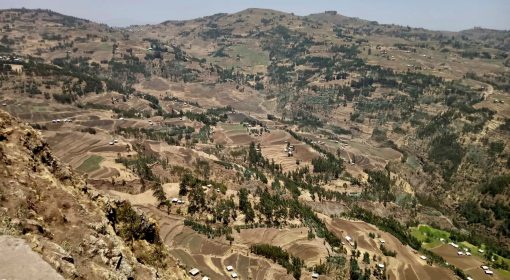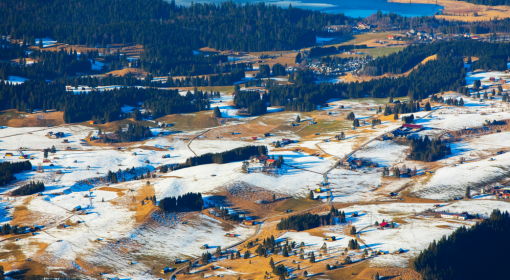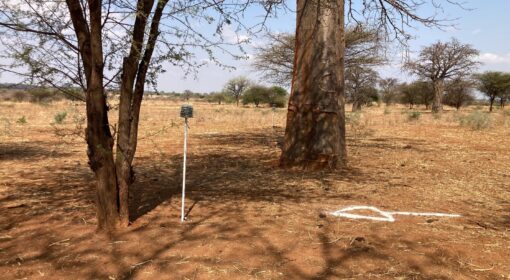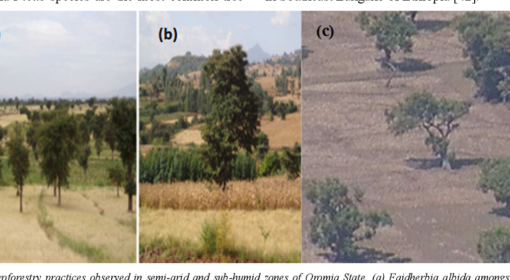by Femke van Woesik, Frank van Steenbergen, Francesco Sambalino
Microclimates are essential regulators of the growth of fungi. Mushrooms, the fruiting bodies of the fungus, prefer a shaded, cool, and moist microclimate to thrive, as the ecological designer Dan Halsey nicely demonstrates in his garden. Furthermore, soil microclimates are essential regulators of the mycelium, the root-like structure of a fungus, as decreasing soil moisture levels can negatively affect their growth and functioning[1].
But fungi themselves also influence the microclimate. If this microclimate is not most suitable for them, they have several abilities to alter this to their needs. What if mushrooms need to distribute their spores, but there is no breeze near them to carry these spores to surrounding areas? They will create wind by themselves. Scientists have revealed this impressive secret of mushrooms, or ‘ingenious engineers’ as Scientist Emilie Dressaire now likes to call them after her discovery. Mushrooms take control of their microclimate by releasing water vapor through evaporation, thereby increasing the air humidity and lowering the temperature of the surrounding air. This leads to a denser air zone, creating small wind patterns around the toadstool. Then the mushroom uses these self-created wind currents to distribute spores to surrounding areas. Because of this, mushrooms can disperse their spores over a wide area even when there is not a breath of wind, showing their extraordinary ability to control the weather. Furthermore, this research showed that air temperatures around different mushrooms were 1-2°C cooler than the ambient air, the mushroom itself being around 4°C cooler than the surrounding air. The lower temperatures result from the consumption of energy needed for evapotranspiration[2].
This cooling effect of mushrooms was also noticed by the scientists behind the MycoCooler™, a mushroom-based air-cooling system. They showed that fungal specimens are, on average, 2.5°C colder than the surrounding temperature. Based on this finding, they loaded the MycoCooler™ with hypothermic mushrooms, cooling the entered air. A prototype model reduced temperature in a closed compartment by approximately 10°C in 25 minutes[3]. Since fungi make up ~2% of Earth’s biomass (exceeding the biomass of all animals), their ability to cool through evapotranspiration may significantly affect the temperature of local climates.
Next to their ability to cool and create wind, mushrooms have another trick up their sleeves: they can make it rain. Mushrooms disperse millions of tons of fungal spores, making them the largest living particles in the air. Along with plant spores and pollen grains, these living cells may act as nuclei for water condensation in clouds: water condenses on the spore surfaces and forms rain droplets. Through this mechanism, mushroom spores may promote rainfall in ecosystems that support large fungi populations. There is thus a positive feedback mechanism at operation in which fungi whose growth is stimulated by rain disperse massive quantities of spores that enhance precipitation[4]. However, as fungi thrive in more moist environments, a lack of rain could result in fewer fungi and fewer spores being spread, possibly exacerbating drought[5].
How can these capacities of fungi serve in landscape rehabilitation and farming operations? There is plenty of evidence that fungi can assist in creating low-maintenance and more resilient landscapes. Fungi can release nutrients into soluble forms that plant roots can take up and, hence, have a critical role in building soils[6], they reduce nutrient leaching risks[7], increase drought resilience through redistribution of water into upper soil layers[8], and sequester carbon into the ground[9]. Ecosystems with thriving fungi networks thus store much more carbon than ecosystems without such networks and increase resilience through improved soil quality and drought tolerance. Together with the weather regulating effect, these capacities make mycorrhizal fungi and mushrooms essential features of thriving ecosystems.
Approximately 90% of plant species, including agricultural crops, form symbiotic relationships with fungi networks, providing powerful abilities to forage for nutrients in the soil[10]. These fungal associations between plant roots and beneficial fungi are called Mycorrhizas. Mycorrhizal fungi increase the adaptation of crops to abiotic stress; they can strengthen crop species against salinity, heat, and water-limiting conditions[11]. Consequently, an increasing amount of research is emerging on how fungi can play a more prominent role in farming and simultaneously be used for food and ecosystem rehabilitation. An example is the production of the milk cap fungus on newly planted trees, where the mushroom can be used as a protein source while the fungus-inoculated trees help in ecosystem conservation and rehabilitation[12].
Another example is cover crops to boost mycorrhizal fungi in the soil. These fungi can only grow and reproduce in partnership with a host plant. Cover crops can fulfill this host role after the main crop is harvested. Research from South Dakota State University showed that a five-way cover crop mix significantly increased the number of fungi in the soils by up to three times compared to soils with no cover crop[13].
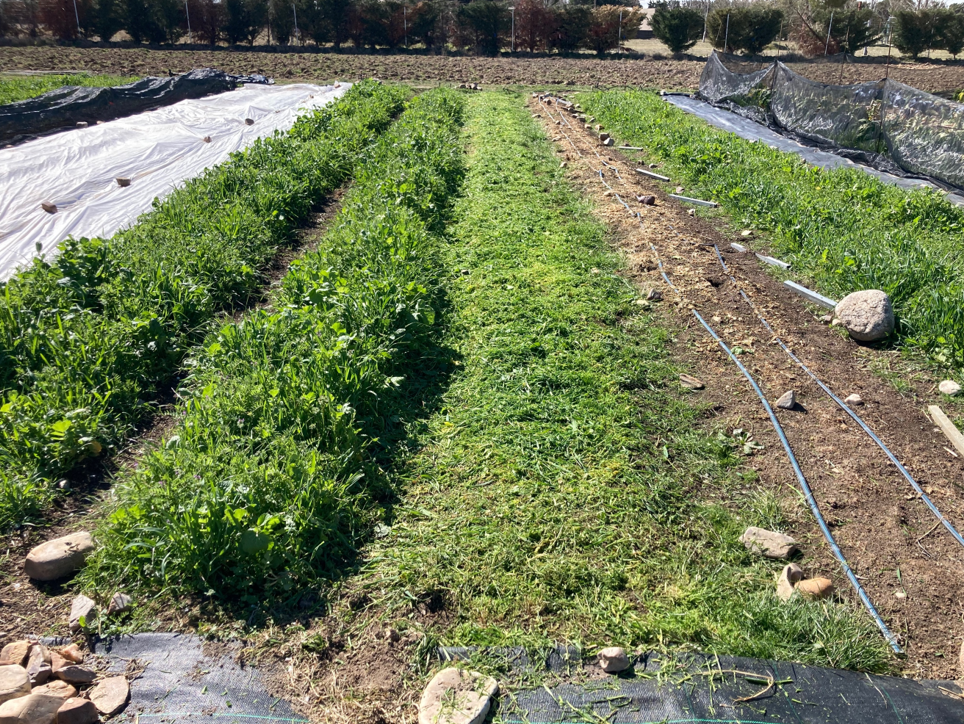
Unfortunately, agricultural practices can also pose a severe threat to fungal systems. Extensive plowing can damage the underground fungal networks, and chemical fertilizer can interrupt the exchange dynamics between plants and fungi, leading to fungal stress and fungal networks being destroyed at an increasing rate. Scientists are therefore warning about the alarming rate at which this is happening. SPUN, a non-profit science-based initiative founded to map fungal networks and advocate for their protection, is one example of an initiative that pledges to protect fungal networks. Some of the practices they are advising are to (1) maintain above-ground soil coverage with native flora and organic material to keep underground networks productive, (2) encourage no-till agriculture methods that leave the underground network intact, (3) nourish the soil with manure and compost and avoid synthetic fertilizers, (4) cover soil with organic matter, (5) plant native plants that depend on fungal networks[1]. Moreover, as mentioned earlier, creating conducive (soil) microclimates (e.g., by applying mulch to keep an area cooler and more humid) will allow for better fungal growth.
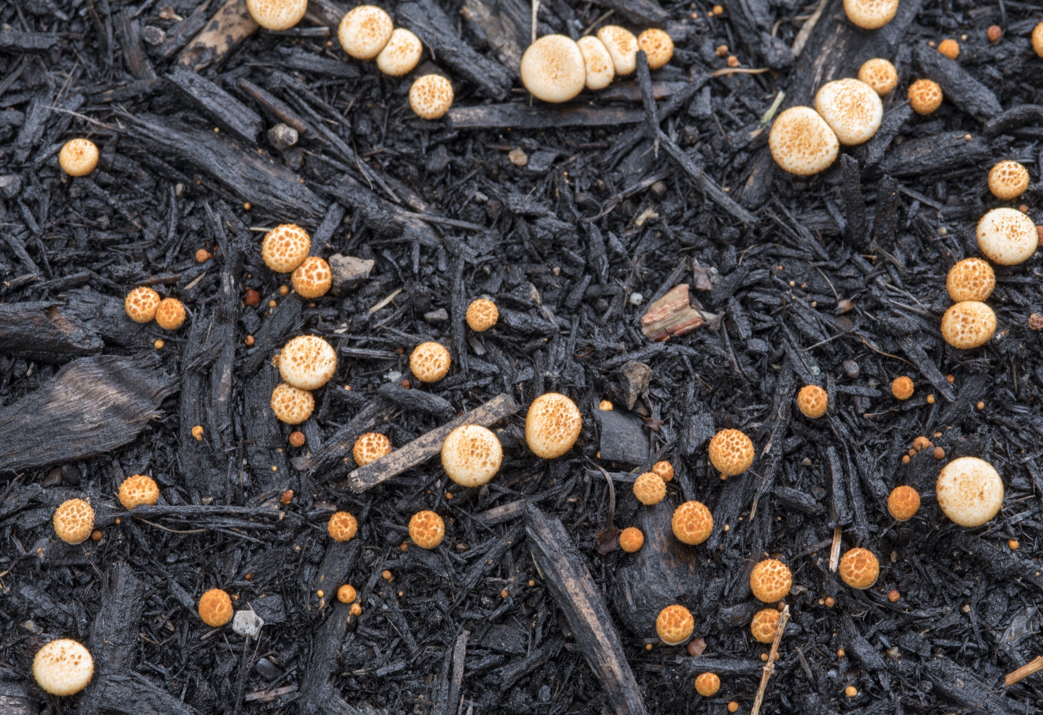
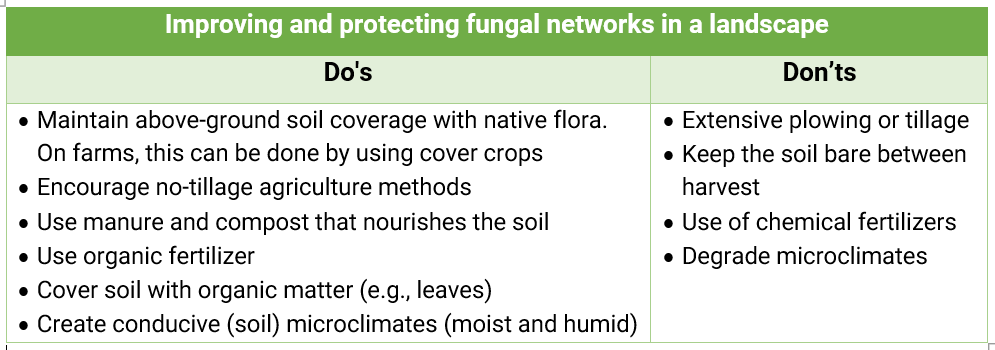
Fungi can thus be a powerful tool for restoring, replenishing, and remediation of local climates and agricultural ecosystems. This should be a symbiotic relationship between fungi and farmers. As Paul Stamets wrote in his article ‘Earth’s Natural Internet’: “Native people worldwide have viewed fungi as spiritual allies. They are not only the guardians of the forest. They are the guardians of our future“[1]. For fungi to help us rehabilitate ecosystems and create conducive conditions for farming, we should create suitable microclimates and conditions for fungi to grow in the first place.
Besides the practical ways fungi can help us restore landscapes, we should also be inspired by them. Like mushrooms creating their wind in times of absence, we should not wait around and adapt to a world with higher temperatures and less resilient ecosystems. Instead, we should create conducive and resilient microclimates in which we can thrive.
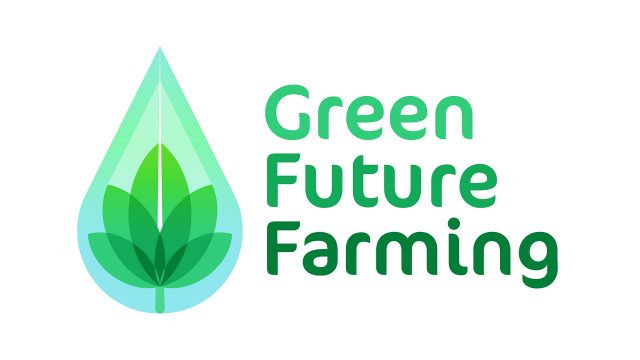
References
[1] https://paulstamets.com/mycorestoration/helping-the-ecosystem-through-mushroom-cultivation
[1] https://spun.earth/action/
[1] Castaño, C., Lindahl, B. D., Alday, J. G., Hagenbo, A., Martínez de Aragón, J., Parladé, J., … & Bonet, J. A. (2018). Soil microclimate changes affect soil fungal communities in a Mediterranean pine forest. New Phytologist, 220(4), 1211-1221. https://doi.org/10.1111/nph.15205
[2] Dressaire, E., Yamada, L., Song, B., & Roper, M. (2016). Mushrooms use convectively created airflows to disperse their spores. Proceedings of the National Academy of Sciences, 113(11), 2833-2838. https://doi.org/10.1073/pnas.1509612113
[3] Cordero, R. J., Mattoon, E. R., & Casadevall, A. (2020). Fungi are colder than their surroundings. BioRxiv. https://doi.org/10.1101/2020.05.09.085969
[4] Hassett, M. O., Fischer, M. W., & Money, N. P. (2015). Mushrooms as rainmakers: how spores act as nuclei for raindrops. PloS one, 10(10), e0140407. https://doi.org/10.1371/journal.pone.0140407
[5] https://www.popsci.com/mushrooms-may-help-bring-rain-to-forest-ecosystems/
[6] https://www.ecolandscaping.org/01/designing-ecological-landscapes/trees/seeing-the-potential-of-wood-inhabiting-fungi-in-the-managed-landscape/
[7] Martínez‐García, L. B., De Deyn, G. B., Pugnaire, F. I., Kothamasi, D., & van der Heijden, M. G. (2017). Symbiotic soil fungi enhance ecosystem resilience to climate change. Global Change Biology, 23(12), 5228-5236. https://doi.org/10.1111/gcb.13785
[8] Pickles, B. J., & Simard, S. W. (2017). Mycorrhizal networks and forest resilience to drought. In Mycorrhizal mediation of soil (pp. 319-339). Elsevier. https://doi.org/10.1016/B978-0-12-804312-7.00018-8
[9] https://www.theguardian.com/commentisfree/2021/nov/30/fungi-climate-crisis-ally
[10] https://spun.earth/climate/
[11] Yadav, A. N., Mishra, S., Kour, D., Yadav, N., & Kumar, A. (Eds.). (2020). Agriculturally important fungi for sustainable agriculture. Cham: Springer.
[12] Thomas, P. W., & Vazquez, L. B. (2022). A novel approach to combine food production with carbon sequestration, biodiversity and conservation goals. Science of The Total Environment, 806, 151301. https://doi.org/10.1016/j.scitotenv.2021.151301
[13] https://extension.sdstate.edu/fall-cover-crops-boost-soil-arbuscular-mycorrhizal-fungi-which-can-lead-reduced-inputs
